
Acyclovir is a very popular treatment for herpes viruses. Is such a drug prescribed for children, can it be used for acute respiratory infections and colds, and also how to give Acyclovir in tablets correctly?

Release form
Acyclovir is available in several forms:
- Pills... They are white, flat and at risk. Each tablet contains 200 mg or 400 mg of active ingredient. They are packed in blisters of 5-20 pieces, and one pack contains from 10 to 100 tablets.
- External treatment cream. It is represented by a homogeneous white mass. The percentage of active substance in this Acyclovir is 5%. One tube can hold 2 g, 5 g or 10 g of cream. Also, the drug can be packaged in jars, from 5 to 50 g of cream in one package.
- Ointment for external treatment. It has a viscous consistency and is white or yellowish-white in color. The concentration of the active ingredient in this form of Acyclovir is also 5%. The drug is placed in aluminum tubes or glass jars, and the weight of the drug in one package varies from 2 g to 30 g.
- Eye ointment. It is a yellow or white mass. The concentration of the active substance in this dosage form is 3%. One tube of ointment contains 3 or 5 g of the drug.
- Powder, from which a solution is prepared for injection into a vein. One bottle may contain 0.25 g, 0.5 g or 1 g of active substance. The number of bottles in one package is 1, 5 or 10.
Such forms of medicine as syrup, suppositories or suspension are not produced.

Composition
The main component of any form of medication that provides its therapeutic effect is acyclovir. Additional substances differ in different types of the drug:
- In the cream, they are represented by vaseline oil, cetyl alcohol, macrolog, propylene glycol, water and other chemicals.
- In Acyclovir ointment, propylene glycol, water, emulsifiers, nipazole and other compounds act as auxiliary ingredients.
- Microcrystalline cellulose, starch, Mg stearate, crosscarmellose Na and other substances are added to the tablets.
- There are no additional chemical compounds in the injection form.
A practicing dermatovenerologist tells about the benefits, principle of action and possible side effects of the drug Acyclovir in the following video: Vyacheslav Vasilievich Makarchuk.
Operating principle
Acyclovir is an antiviral agent, effectively affecting:
- Herpesviruses 1 and 2 types.
- Varicella Zoster viruses.
- Epstein-Barr viruses.
- Cytomegalovirus.
The drug directly affects the DNA in viral cells, as a result of which the reproduction of the pathogen stops. Having penetrated the cells of the virus, the drug breaks off the DNA chains and interferes with its replication. At the same time, Acyclovir has almost no effect on the cells of the patient's body.
The use of such an antiviral drug prevents the spread of the rash, accelerates the healing of the affected skin, and reduces soreness with herpes zoster. Acyclovir also has an immunostimulating effect.
Indications
The use of Acyclovir is shown:
- With herpes infection... The medicine is used topically for herpes on the lips, as well as on the genitals. The drug is indicated for herpes sore throat, dermatitis, stomatitis and conjunctivitis provoked by the herpes simplex virus.
- With severe or moderate chickenpox. Acyclovir is advised to be used for chickenpox in infants up to a year (for example, at 10 months), since in the first year of life this infectious disease is characterized mainly by a severe course. Also, the drug is used for congenital chickenpox.
- With shingles. This disease, triggered by the same virus as chickenpox, is more likely to occur in old age.
- For preventive purposes, if the child has an immunodeficiency and there is a high risk of infection with pathogens sensitive to Acyclovir.
In addition, the use of Acyclovir is in demand for infectious mononucleosis. With flu and ARVI, such a medicine is often not used, since it does not act on their pathogens, but can be prescribed for prophylactic purposes with a high risk of herpes infection.

From what age is it allowed to take?
Treatment of the baby's skin with cream or ointment Acyclovir is permissible from birth. When indicated, the drug in the form of intravenous injections can be used at any age, including for an infant. As for the tablets, such Acyclovir is given from 1 year.
You may be interested in watching the release of the program of the famous children's doctor Yevgeny Komarovsky, dedicated to the herpes virus in children:
Contraindications
Treatment with Acyclovir is not recommended:
- In the presence of hypersensitivity to any component of the drug.
- With a mild form of chickenpox.
- With bacterial infections, for example, with streptoderma.
With dehydration, neurological problems or renal pathologies, Acyclovir should be used with caution. 5% ointment or cream should not be applied to mucous membranes.
You may be interested in watching the release of the program of the famous children's doctor Yevgeny Komarovsky, dedicated to the herpes virus in children:
Side effects
- Acyclovir is noted for its ability to influence the central nervous system. Taking this medication can lead to dizziness, weakness, fatigue, drowsiness, tremors of the extremities, headaches. Occasionally, a small patient may experience hallucinations.
- The child's digestive system may respond to treatment with Acyclovir with diarrhea, nausea, liver dysfunction, abdominal pain, and vomiting. Many mothers are interested in how to support the liver while taking Acyclovir, but if this organ is healthy in a child, additional medications are not required to support it. If the doctor has detected liver disease, he will prescribe hepatoprotective drugs along with Acyclovir.
- Taking Acyclovir can provoke a decrease in the level of erythrocytes and leukocytes in the blood, as well as changes in the number of platelets.
- External use of the drug sometimes causes skin irritation or flaking. Also, an allergy in the form of a rash may occur at the lubrication site.
- If the medicine is given intravenously, it can cause serious side effects such as kidney failure or seizures. In rare cases, such use of Acyclovir leads to psychosis or coma.
- Phlebitis may occur at the injection site of the drug into a vein, and if Acyclovir accidentally gets under the skin, then necrosis is possible.
- Eye ointment can cause conjunctivitis, blepharitis, keratopathy, or severe burning when applied to the mucous membrane.

Instructions for use and dosage
Pills
For the treatment of infections caused by herpes simplex viruses, a single dose of children 1-2 years old is often prescribed 1/2 tablet, and children over two years old - a whole tablet. The drug is taken four or five times a day. The tablet is recommended to be washed down with plenty of water.... The average duration of therapy with Acyclovir is 5 days, however, if indicated, the tablets can be drunk for up to 10 days.
With chickenpox, a single dosage of Acyclovir tablets is often selected individually, since for effective treatment a small child needs to calculate the dose by weight. It is 20 mg of active substance for every kilogram of the baby's weight. The calculated dose is given 4 times a day for 5 days.

For example, a child at 1.5 years old weighs 11 kilograms and, according to calculations, a single dosage will be 220 mg, so he is given 1 tablet each containing 200 mg of acyclovir. And at 7 years old with a weight of 21 kg, 420 mg of the active substance is required per 1 dose, so the child can be given both 2 tablets with 200 mg of acyclovir, and 1 tablet, which contains 400 mg of the drug. The maximum single dose is 800 mg of acyclovir.
For prophylaxis, Acyclovir is prescribed in tablets with a high risk of herpes infection and low immune defense. The dosage of the drug is 2 tablets for 1 dose, if the drug is drunk every 12 hours, or 1 tablet four times a day.
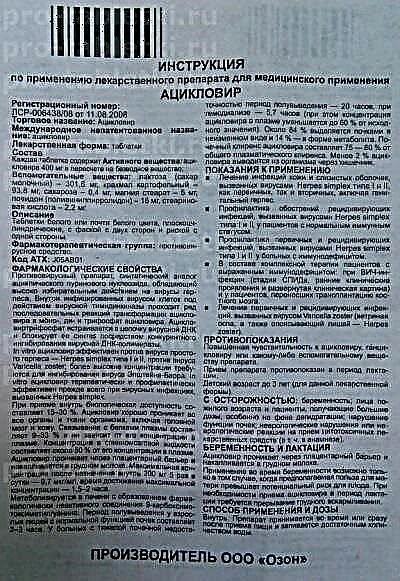
External means
Ointment Acyclovir gently treat the affected areas of the skin, trying not to smear clean skin with the drug, since the medicine forms a dense film on the surface. The dosage of the ointment is determined by the doctor, taking into account the weight of the baby and the area of his skin. The treatment of the rash begins from the very first days of appearance, but at night the medicine is not applied to the skin. The treatment often lasts 5 days.
Acyclovir cream Apply with a clean hand or a cotton swab to the affected skin up to 5 times a day. The amount of the drug in this form is determined individually. Skin treatment is prescribed for a period of 5 to 10 days.
Eye ointment apply 5 times a day with pauses between insertions in the lower conjunctival sac for about 4 hours. A strip of ointment for 1 application has a length of approximately 1 cm. After recovery, the treatment is continued for at least three more days.
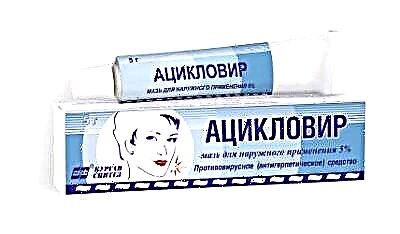
Injections
The dosage of Acyclovir for intravenous injections is calculated by body weight (in newborns) or by body surface area (in children over 3 months old). The drug is administered at intervals of 8 hours to monitor kidney function. If the analyzes show changes in creatinine levels, the dosage is adjusted.
Injections are often given within five days. but depending on the disease and the patient's response to treatment, injections may be prescribed for a longer period. For example, for herpes encephalitis, Acyclovir is administered for 10 days.
Acyclovir injection is a slow infusion over one hour or longer (the medicine is administered by drip). To make an injection, water for injection or sodium chloride solution is added to the powder. Acyclovir can also be combined with glucose solutions.

Overdose
Overdose cases with local use of Acyclovir have not been noted. If you take many tablets of this drug by mouth, it will lead to neurological damage, nausea, headaches, shortness of breath, loose stools, or vomiting. In severe cases, exceeding the dosage causes renal failure, seizures and coma. In the treatment, symptomatic therapy and measures aimed at maintaining vital functions are used.
Interaction with other drugs
If acyclovir is taken together with other medicines that have a toxic effect on the kidneys, it will increase the nephrotoxic effect of the treatment.
Terms of sale
You do not need to present a doctor's prescription to buy any dosage form of Acyclovir.

Storage conditions and shelf life
The storage area for Acyclovir should be dry, protected from direct sunlight and out of reach of babies. The optimal temperature range for storing the cream is + 12 + 15 ° С, and ointments or tablets - + 15 + 25 ° С.
After the release date of the tablet form, it can be stored for up to 3 years. The cream has a shelf life of 2 years. An opened tube of eye ointment should be used 1 month in advance.
Reviews
In most cases of the use of Acyclovir, this medicine responds positively. Parents love the drug's quick effect and the many dosage forms, and side effects such as headaches, nausea or allergies are often noted among the disadvantages. Mothers who gave Acyclovir to a child with moderate chickenpox confirm that the medicine effectively helps with fever and profuse chickenpox rashes.
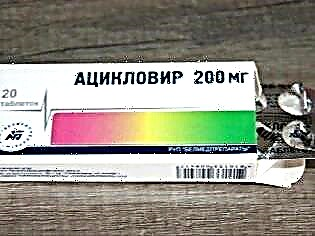

Analogs
Acyclovir can be replaced by other drugs that have the same active substance and the same effect. The most popular of these drugs are:
- Zovirax... Such an analogue of Acyclovir is produced by a British company in the form of tablets (each containing 200 mg of acyclovir), 5% cream, eye ointment with an active ingredient concentration of 3% and a powder for injection packaged in vials.
- Acyclovir-Acri... This domestic drug is represented by 5% ointment and tablets with two dosages of the active compound (200 and 400 mg).


- Virolex... Such antiviral medication is produced in Slovenia in the form of tablets (each containing 200 mg of active ingredient), 3% eye ointment, lyophilisate for injections, and 5% cream.
- Cyclovir... This Indian drug is represented by a cream with a 5% acyclovir concentration and tablets containing 200 mg of the active ingredient.
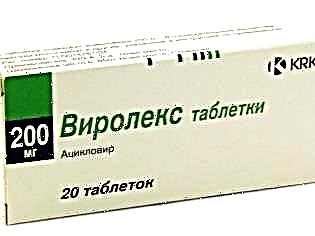

- Acyclovir HEXAL. This antiviral drug is produced in Germany in the form of a topically applied 5% cream.
- Vivorax... This Indian analogue of Acyclovir is produced in tablets (each contains 200 mg of active ingredient) and in external form (5% cream).

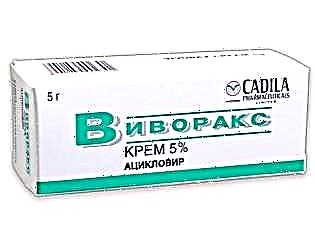
- Acyclovir Belupo. This antiviral drug is produced in Croatia in the form of 5% cream and coated tablets containing 400 mg of acyclovir each.
- Herperax... This is another acyclovir-containing drug from India. It is produced both in tablet form (each tablet provides 200 mg of active compound) and in the form of a 5% ointment.





